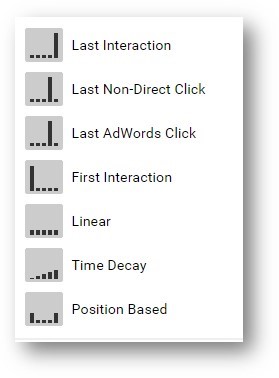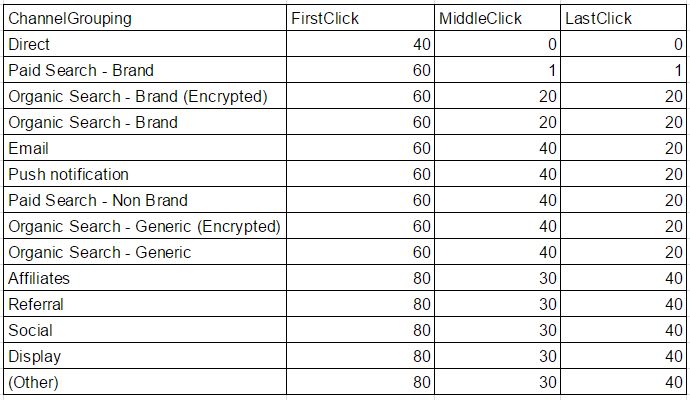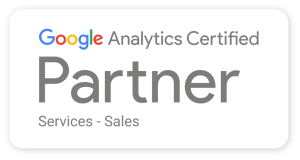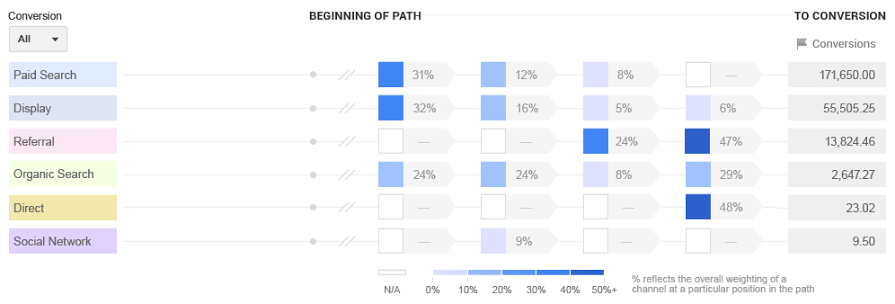As our ability to collect and analyse marketing data improves, we are having more and more conversations with our clients about how to build a custom attribution model, and how tools like those available in the Google Analytics 360 Suite can help.
Successful attribution modelling will enable marketers to present the right information, at the right time, in the right place, and to the right customer, resulting in more sales.
Equally, a successful attribution model will help prevent showing the wrong information, at the wrong time, in the wrong place, or to the wrong customer, resulting in a reduction in wasted marketing spend.
This blog considers some of the factors we take into account when determining which model is best for our clients.
Do you need a custom model?
Before you spend too long considering how best to attribute your conversions to the various channels, it’s worth considering whether this is actually a problem for your business.
Google Analytics (and other Analytics platforms) provide standard models which, depending on your circumstances, may be accurate enough to drive your marketing decisions. For example, if your customers typically purchase on a single visit, and they’re mainly one-off purchases, the standard last non-direct click model may give you all the information you need.
If, however, you have a longer buying cycle with multiple interactions from different channels, you’ll need a more sophisticated attribution model if you want to identify which channels are driving conversions.
All models are flawed: choose the least-worst model
Once you’ve decided if your marketing activity is sufficiently complex to require a customised model, the next step is to acknowledge that all models are flawed.
Attribution is complex, and taking into account all online and offline influences – often accessed via multiple devices – is virtually impossible. The aim is to define a model based on your specific business goals, and to select the ‘least flawed’ option in the context of your typical customer journeys.
Below is a list of models that are available in Google Analytics, and there’s a full explanation of the benefits of each in our blog post about using Google BigQuery to analyse your data.

What is the purpose of your campaign?
The process of finding the best model starts by considering what the purpose of your campaign is.
Are you looking to increase sales/revenue, improve CPA/ROI or simply raise brand awareness? The model you apply will be influenced by the answers to these questions, and what you want to do with the results. For example, the first click would be valued more highly if you’re a new brand in the market, whereas for established brands, the click that drove the conversion would be more relevant.
Collecting data: include everything (OR as much as you can)
It’s not possible to capture data from every interaction your customer has with your brand during the conversion process, but technology and processes can be optimised to capture as much of this information as you can.
As well as every visit to your site, data you should aim to capture includes:
- Email – have customers received email marketing? Did they open the email, or click on the links?
- Programmatic adverts – have they viewed (but not clicked) programmatic ads?
- Offline events – can you track which customers received catalogues or mail-shots?
- Offline orders – have any purchases been made via telephone or mail order?
- Phone calls – can you capture phone call data, and link them to specific campaigns?
- Cross-device visits – if a user visits your site on different devices, can you tie those visits together?
- Refunds/Returns – if clients return goods, can you take this into account?
Give a value to each engagement
All touch points with customers are not necessarily of equal value, so some of our clients apply a weighted model to their engagement data.
Ideally, we would aim to give credit to each visit/channel in proportion with how far that visit drove the user to convert. For example, a visit with an immediate bounce would almost certainly be worth less than a longer session.
If a user stays on the site for twenty minutes, watches a video or adds something to the basket, that session had a greater influence on driving the conversion. Basic metrics such as time on site can be used to achieve this, or in more complex scenarios a calculated ‘session score’ could be created taking into account your top engagement metrics.
Below is an example of an attribution model which applies different weightings to each touch point and where it comes in the user journey.

Brand vs. non-brand
Typically, if we are looking at the value of marketing spend, brand or direct traffic would be down-weighted as it reflects customers who are returning and/or are already aware of your brand.
If a customer journey starts with PPC and they then return directly and convert, most of the credit should be given to the PPC visit which introduced them to your site.
If, on the other hand, the first visit in a conversion path is brand or direct, we’d need to decide how much (or little) credit other channels in that conversion path should take, given the direct visit indicates a degree of existing brand awareness that must have been created elsewhere.
Identify your conversion window
A small but important factor in applying an attribution model is to consider how far back in time you go. This depends on how long the decision-making process is for your business/market, and the point at which interactions become irrelevant to the conversion.
Be prepared to test
Testing can be complex, but the only real way to know if your model is giving you the right answer is to make changes, review the results, and be prepared to change if results don’t improve.
Keep looking at each channel in its own right
Building an attribution model is all about finding the least flawed model which apportions credit to all the channels driving conversions on your site.
However, we should not lose sight of the fact that each channel has a role to play, and they should be evaluated in their own right.
For example, if the objective of a programmatic or social campaign is to raise brand awareness, it may not feature highly in the model, but should still be measured against this goal separately.
Similarly, if a PPC campaign is a short-term effort to increase sales, it has been successful if it achieves this goal irrespective of the value shown in the attribution model.
Data-driven models
The most accurate approach to attribution is to use a ‘data-driven’ model, which looks at all the historical conversion paths in your Analytics account (both with and without conversions) and uses algorithms to determine the effect of each channel on your campaigns.
With Google Analytics 360 this is available as a single-click option within the platform, and allows you to compare the data-driven results against other standard models. Search Laboratory are Google Analytics 360 sales partners, and can help you use these tools to analyse where your customers are coming from.

This approach requires sufficient amounts of data to generate meaningful results from analysis. But if you do have a large volume of data, it is a powerful approach that will become more accurate over time, and it minimises the number of assumptions you have to build into your attribution model. The below images gives you an example:

If you don’t have Google Analytics 360, it is still possible to create your own data-driven model, but you’ll need to make sure you’ve got enough data spread across a number of conversion paths to make the calculations valid, and also have access to suitable analysis software and skills to perform the analysis and maintain the model on an ongoing basis.
Summary: sifting value from data
There’s no quick solution to building a custom attribution model to value your online marketing activity: every business and situation is unique.
Marketers will need to recognise that whichever model you use will have limitations, and that some experimentation will be required to validate your decisions and enhance the model over time.
Despite this, for many of our clients, having a custom attribution model is the key to understanding why, where and how their customers make purchasing decisions, and how they can optimise their marketing campaigns to make it easier for their customers to buy their products as opposed to their competitors’.
How we can help
Search Laboratory has a dedicated and highly qualified Analytics and Data team that works with our clients to develop, enhance and maintain custom attribution models. If you would like to discuss how we can help you drive value from your customer data, please get in touch for a confidential discussion.


